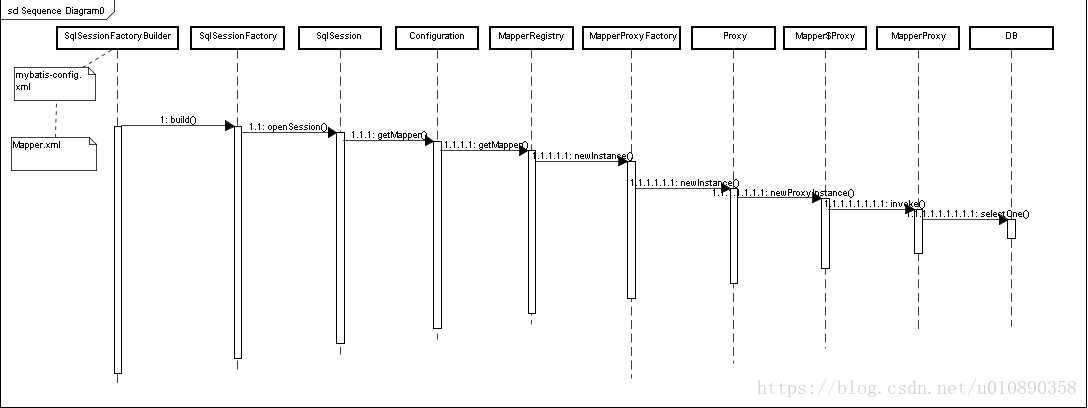标签:get 内容 执行 hand build name null simple 信息
mybatis工作流程:

(1) SqlSessionFactoryBuilder 从 XML 配置文件或通过Java的方式构建出 SqlSessionFactory 的实例。
(2) SqlSessionFactory生成SqlSession。
(3) SqlSession拿到Mapper对象的代理(通过JDK动态代理生成一个Mapper的代理,代理类实现了我们写的Mapper接口)。
(4) 通过MapperProxy调用Maper中相应的方法。
1. 构建SqlSessionFactory过程
构建主要分为2步:
2. MappedStatement
它保存映射器的一个节点(select|insert|delete|update),包括配置的SQL,SQL的id、缓存信息、resultMap、parameterType、resultType等重要配置内容。
3. SqlSource
它是MappedStatement的一个属性,主要作用是根据参数和其他规则组装SQL。
4. BoundSql
对于参数和SQL,主要反映在BoundSql类对象上,在插件中,通过它获取到当前运行的SQL和参数以及参数规则,作出适当的修改,满足特殊的要求。
BoundSql提供3个主要的属性:parameterObject、parameterMappings和sql。
parameterObject为参数本身,可以传递简单对象、POJO、Map或@Param注解的参数:
parameterMappings,它是一个List,元素是ParameterMapping对象,这个对象会描绘sql中的参数引用,包括名称、表达式、javaType、jdbcType、typeHandler等信息。
sql,是写在映射器里面的一条sql。
SqlSession运行过程
1. 映射器的动态代理
Mapper映射是通过动态代理来实现的,使用JDK动态代理返回一个代理对象,供调用者访问。
首先看看实现InvocationHandler接口的类,它是执行本代理方法的关键,可以看到,Mapper是一个接口,会生成MapperMethod对象,调用execute方法。
public class MapperProxy<T> implements InvocationHandler, Serializable { ..... @Override public Object invoke(Object proxy, Method method, Object[] args) throws Throwable { try { if (Object.class.equals(method.getDeclaringClass())) { return method.invoke(this, args); } else if (isDefaultMethod(method)) { return invokeDefaultMethod(proxy, method, args); } } catch (Throwable t) { throw ExceptionUtil.unwrapThrowable(t); } final MapperMethod mapperMethod = cachedMapperMethod(method); return mapperMethod.execute(sqlSession, args); } }
MapperMethod采用命令模式,根据不同的sql操作,做不同的处理。
public class MapperMethod { public Object execute(SqlSession sqlSession, Object[] args) { Object result; switch (command.getType()) { case INSERT: { Object param = method.convertArgsToSqlCommandParam(args); result = rowCountResult(sqlSession.insert(command.getName(), param)); break; } case UPDATE: { Object param = method.convertArgsToSqlCommandParam(args); result = rowCountResult(sqlSession.update(command.getName(), param)); break; ...... } } }
最后看下,生成代理类的方法,就是使用JDK动态代理Proxy来创建的。
public class MapperProxyFactory<T> { public T newInstance(SqlSession sqlSession) { final MapperProxy<T> mapperProxy = new MapperProxy<T>(sqlSession, mapperInterface, methodCache); return newInstance(mapperProxy); } @SuppressWarnings("unchecked") protected T newInstance(MapperProxy<T> mapperProxy) { return (T) Proxy.newProxyInstance(mapperInterface.getClassLoader(), new Class[] { mapperInterface }, mapperProxy); } }
总结下映射器的调用过程,返回的Mapper对象是代理对象,当调用它的某个方法时,其实是调用MapperProxy#invoke方法,而映射器的XML文件的命名空间对应的就是这个接口的全路径,根据全路径和方法名,便能够绑定起来,定位到sql,最后会使用SqlSession接口的方法使它能够执行查询。
2. SqlSession下的四大对象
映射器就是一个动态代理对象,进入到了MapperMethod的execute方法,它经过简单的判断就进入了SqlSession的删除、更新、插入、选择等方法。Mapper执行的过程是通过Executor、StatementHandler、ParameterHandler和ResultHandler来完成数据库操作和结果返回的。
在MyBatis中存在三种执行器:
以SimpleExecutor为例,说明执行过程:
public class SimpleExecutor extends BaseExecutor { /** * 执行查询操作 */ public <E> List<E> doQuery(MappedStatement ms, Object parameter, RowBounds rowBounds, ResultHandler resultHandler, BoundSql boundSql) throws SQLException { Statement stmt = null; try { Configuration configuration = ms.getConfiguration(); StatementHandler handler = configuration.newStatementHandler(this, ms, parameter, rowBounds, resultHandler, boundSql); stmt = prepareStatement(handler, ms.getStatementLog()); return handler.<E>query(stmt, resultHandler); } finally { closeStatement(stmt); } } /** * 初始化StatementHandler */ private Statement prepareStatement(StatementHandler handler, Log statementLog) throws SQLException { Statement stmt; Connection connection = getConnection(statementLog); stmt = handler.prepare(connection); handler.parameterize(stmt); return stmt; } /** * 执行查询 */ @Override public <E> List<E> query(Statement statement, ResultHandler resultHandler) throws SQLException { String sql = boundSql.getSql(); statement.execute(sql); return resultSetHandler.<E>handleResultSets(statement); } }
可以看到最后会委托给StatementHandler会话器进行处理,它是一个接口,实际创建的是RoutingStatementHandler对象,但它不是真实的服务对象,它是通过适配器模式找到对应的StatementHandler执行的。在MyBatis中,StatementHandler和Executor一样分为三种:SimpleStatementHandler、PreparedStatementHandler、CallableStatementHandler。
Executor会先调用StatementHandler的prepare方法预编译SQL语句,同时设置一些基本运行的参数。然后调用parameterize()方法启用ParameterHandler设置参数,完成预编译,跟着执行查询,用ResultHandler封装结果返回给调用者。
标签:get 内容 执行 hand build name null simple 信息
原文地址:https://www.cnblogs.com/myitnews/p/11565178.html